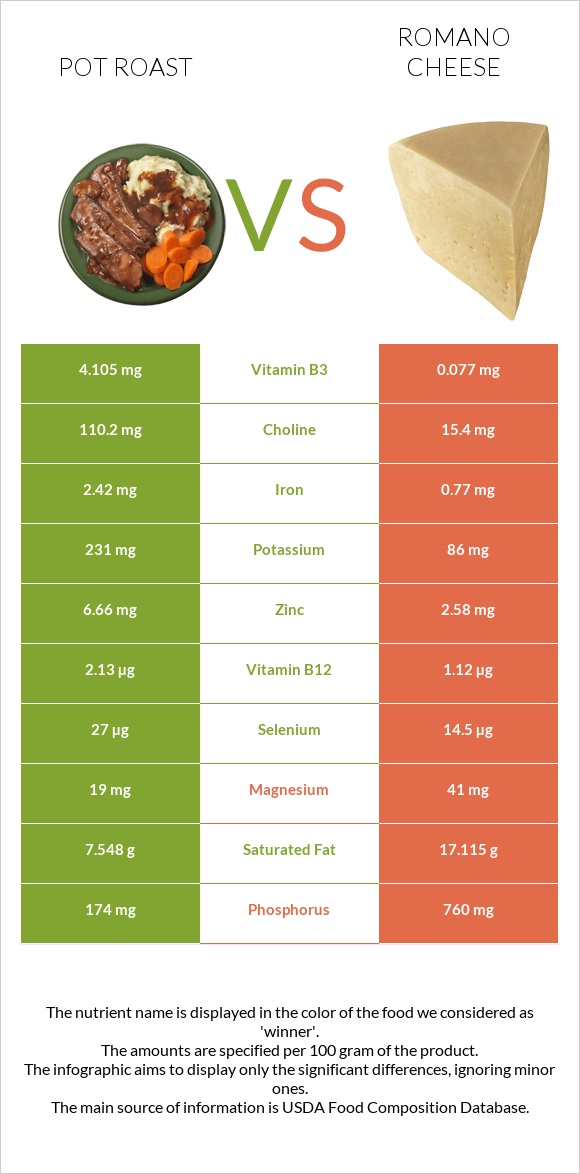Pot roast vs. Romano cheese — In-Depth Nutrition Comparison
Compare
Differences between pot roast and romano cheese
- Pot roast has more vitamin B12, zinc, vitamin B3, selenium, iron, and choline, while romano cheese has more calcium and phosphorus.
- Romano cheese's daily need coverage for calcium is 105% higher.
- Romano cheese contains 53 times less vitamin B3 than pot roast. Pot roast contains 4.105mg of vitamin B3, while romano cheese contains 0.077mg.
- The amount of saturated fat in pot roast is lower.
- Pot roast has a lower glycemic index. The glycemic index of pot roast is 0, while the glycemic index of romano cheese is 27.
The food types used in this comparison are Beef, chuck, arm pot roast, separable lean, and fat, trimmed to 0" fat, all grades, cooked, braised and Cheese, romano.
Infographic

Infographic link
Mineral Comparison
Mineral comparison score is based on the number of minerals by which one or the other food is richer. The "coverage" charts below show how much of the daily needs can be covered by 300 grams of the food.
| Contains more PotassiumPotassium | +168.6% |
| Contains more IronIron | +214.3% |
| Contains more CopperCopper | +230% |
| Contains more ZincZinc | +158.1% |
| Contains less SodiumSodium | -96.7% |
| Contains more SeleniumSelenium | +86.2% |
| Contains more MagnesiumMagnesium | +115.8% |
| Contains more CalciumCalcium | +6550% |
| Contains more PhosphorusPhosphorus | +336.8% |
| Contains more ManganeseManganese | +100% |
Vitamin Comparison
Vitamin comparison score is based on the number of vitamins by which one or the other food is richer. The "coverage" charts below show how much of the daily needs can be covered by 300 grams of the food.
| Contains more Vitamin EVitamin E | +121.7% |
| Contains more Vitamin B1Vitamin B1 | +59.5% |
| Contains more Vitamin B3Vitamin B3 | +5231.2% |
| Contains more Vitamin B5Vitamin B5 | +34.7% |
| Contains more Vitamin B6Vitamin B6 | +232.9% |
| Contains more Vitamin B12Vitamin B12 | +90.2% |
| Contains more FolateFolate | +28.6% |
| Contains more Vitamin AVitamin A | +∞% |
| Contains more Vitamin DVitamin D | +150% |
| Contains more Vitamin B2Vitamin B2 | +116.4% |
| Contains more Vitamin KVitamin K | +22.2% |
All nutrients comparison - raw data values
| Nutrient |  |
 |
DV% diff. |
| Calcium | 16mg | 1064mg | 105% |
| Phosphorus | 174mg | 760mg | 84% |
| Sodium | 47mg | 1433mg | 60% |
| Saturated fat | 7.548g | 17.115g | 43% |
| Vitamin B12 | 2.13µg | 1.12µg | 42% |
| Zinc | 6.66mg | 2.58mg | 37% |
| Vitamin B3 | 4.105mg | 0.077mg | 25% |
| Selenium | 27µg | 14.5µg | 23% |
| Iron | 2.42mg | 0.77mg | 21% |
| Choline | 110.2mg | 15.4mg | 17% |
| Vitamin B2 | 0.171mg | 0.37mg | 15% |
| Vitamin B6 | 0.283mg | 0.085mg | 15% |
| Fats | 19.17g | 26.94g | 12% |
| Vitamin A | 0µg | 96µg | 11% |
| Copper | 0.099mg | 0.03mg | 8% |
| Protein | 28.94g | 31.8g | 6% |
| Calories | 297kcal | 387kcal | 5% |
| Magnesium | 19mg | 41mg | 5% |
| Cholesterol | 116mg | 104mg | 4% |
| Potassium | 231mg | 86mg | 4% |
| Vitamin B5 | 0.571mg | 0.424mg | 3% |
| Vitamin D | 8 IU | 20 IU | 2% |
| Vitamin E | 0.51mg | 0.23mg | 2% |
| Vitamin D | 0.2µg | 0.5µg | 2% |
| Vitamin B1 | 0.059mg | 0.037mg | 2% |
| Carbs | 0g | 3.63g | 1% |
| Folate | 9µg | 7µg | 1% |
| Monounsaturated fat | 8.175g | 7.838g | 1% |
| Polyunsaturated fat | 0.708g | 0.593g | 1% |
| Net carbs | 0g | 3.63g | N/A |
| Sugar | 0g | 0.73g | N/A |
| Manganese | 0.01mg | 0.02mg | 0% |
| Vitamin K | 1.8µg | 2.2µg | 0% |
| Tryptophan | 0.19mg | 0.429mg | 0% |
| Threonine | 1.156mg | 1.171mg | 0% |
| Isoleucine | 1.317mg | 1.685mg | 0% |
| Leucine | 2.302mg | 3.071mg | 0% |
| Lysine | 2.446mg | 2.941mg | 0% |
| Methionine | 0.754mg | 0.852mg | 0% |
| Phenylalanine | 1.143mg | 1.71mg | 0% |
| Valine | 1.436mg | 2.183mg | 0% |
| Histidine | 0.924mg | 1.231mg | 0% |
Macronutrient Comparison
Macronutrient breakdown side-by-side comparison
Protein:
28.94 g
Fats:
19.17 g
Carbs:
0 g
Water:
51.9 g
Other:
0 g
Protein:
31.8 g
Fats:
26.94 g
Carbs:
3.63 g
Water:
30.91 g
Other:
6.72 g
| Contains more WaterWater | +67.9% |
| Contains more FatsFats | +40.5% |
| Contains more CarbsCarbs | +∞% |
| Contains more OtherOther | +∞% |
~equal in
Protein
~31.8g
Fat Type Comparison
Fat type breakdown side-by-side comparison
Saturated fat:
Sat. Fat
7.548 g
Monounsaturated fat:
Mono. Fat
8.175 g
Polyunsaturated fat:
Poly. Fat
0.708 g
Saturated fat:
Sat. Fat
17.115 g
Monounsaturated fat:
Mono. Fat
7.838 g
Polyunsaturated fat:
Poly. Fat
0.593 g
| Contains less Sat. FatSaturated fat | -55.9% |
| Contains more Poly. FatPolyunsaturated fat | +19.4% |
~equal in
Monounsaturated fat
~7.838g





